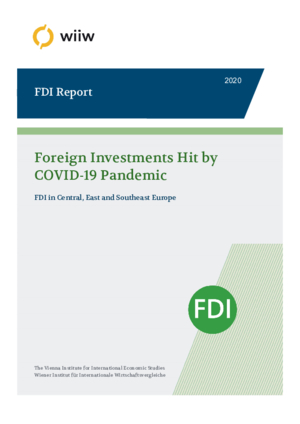Foreign Investments Hit by COVID-19 Pandemic. FDI in Central, East and Southeast Europe
wiiw FDI Report No. 2020-12, December 2020
59 pages including 26 Tables and 12 Figures
FDI inflows to Central, East and Southeast Europe (CESEE – 23 economies) declined by 58% in the first half of 2020, against the same period of 2019. This drop is more dramatic than the global plunge in FDI (49%, estimated by UNCTAD), but is smaller than the setback faced by the developed economies (75%). The CESEE country groups have been unevenly affected: the decline has amounted to 35% in the EU-CEE, 8% in the Western Balkans, and about 40% in both the group of the CIS plus Ukraine and in Turkey. Russia recorded negative FDI inflows in the first half of 2020, following unusually high amounts a year before. In EU-CEE, FDI had already started to decline in 2019, putting an end to a three-year growth period.
The capital pledged in greenfield investment projects in CESEE fell by 23% – less than the global decline of 34% in the first half of 2020. The quarter-to-quarter decline in 2020 was sharpest in the second quarter and was followed by a levelling-off in the third. In annual comparison, the capital commitments were 41% lower in the first three quarters of 2020 than in the previous year.
Manufacturing was more vulnerable to the recession than other sectors – in terms of both FDI flows and greenfield investments. Participation in global value chains has suffered from demand and supply shocks, and from disruption to production, trade and supply networks. This may yet provide an impulse to shorten value chains, relocate and ‘back-shore’ cross-border production-sharing activities in the future, which may depress FDI.
Technological change may also bring some redistribution of locations for manufacturing production and tradable services in the medium and longer term. However, European value chains may soon recover from the initial shocks, and international investors are under no pressure to undertake costly relocations. Re-shoring will be slow if Asia remains the growth engine of the world economy. The automotive industry will face transformation as it adapts to new technologies, but will keep most of its established locations in the region. Most of CESEE may gain from the near-shoring of production by European companies, as they move away from more distant locations.
The wiiw FDI Database is available online
This online access with a modern query tool supports easy search and download of data.
The wiiw FDI Database contains the full set of FDI data with time series starting form 1990 as far as available.
Access to wiiw FDI Database
Reference to wiiw databases: wiiw Annual Database, wiiw FDI Database
Keywords: foreign direct investment, balance of payments, COVID-19 crisis, re-shoring, back-shoring, new EU member states, Central Europe, Southeast Europe, Western Balkans, Austria, China, Turkey, CIS, Russia, Ukraine
JEL classification: C82, F21, O57, P23
Countries covered: Albania, Belarus, Bosnia and Herzegovina, Bulgaria, CIS, Croatia, Czechia, Estonia, Hungary, Kazakhstan, Kosovo, Latvia, Lithuania, Moldova, Montenegro, New EU Member States, North Macedonia, Poland, Romania, Russia, SEE, Serbia, Slovakia, Slovenia, Turkey, Ukraine
Research Areas: International Trade, Competitiveness and FDI
ISBN-13: 978-3-85209-072-6
